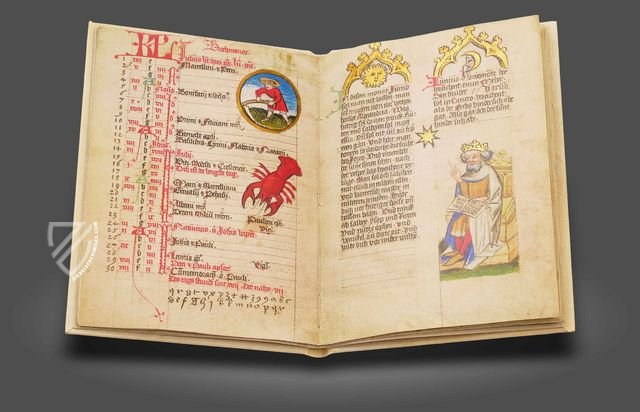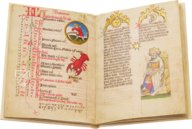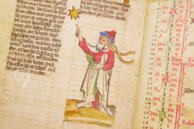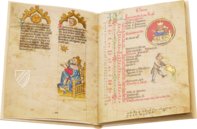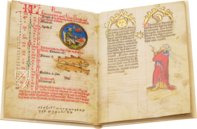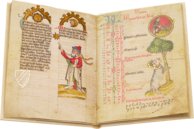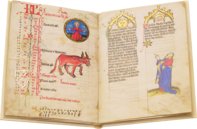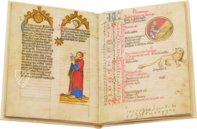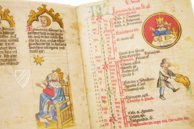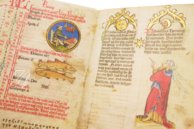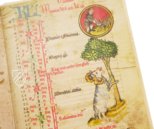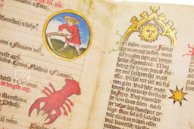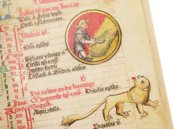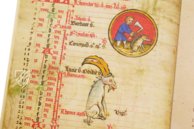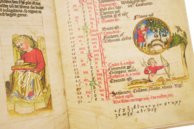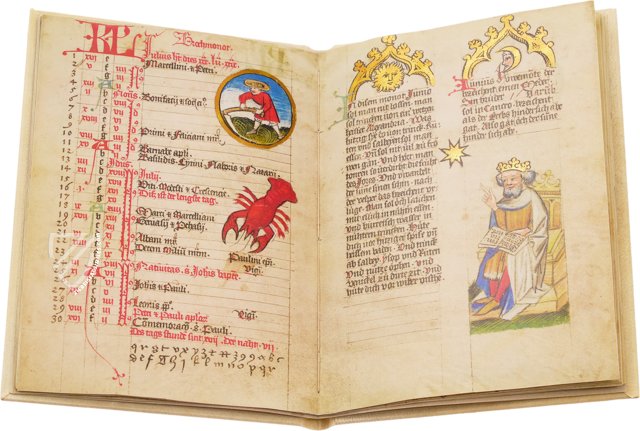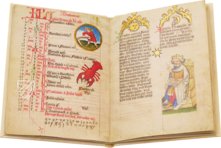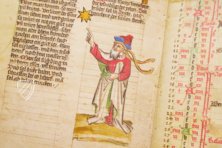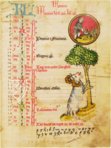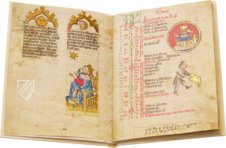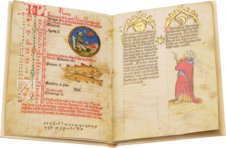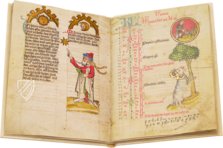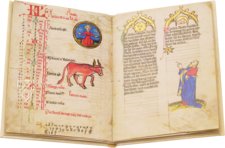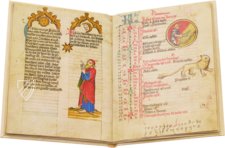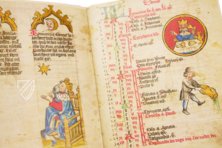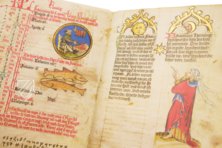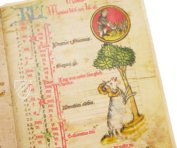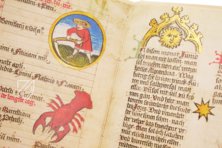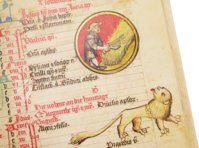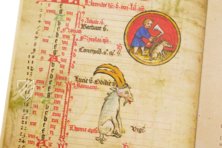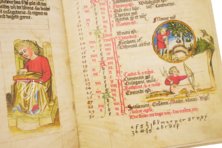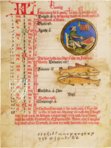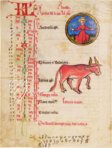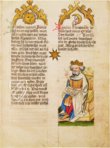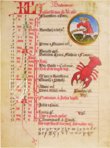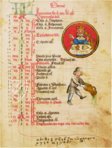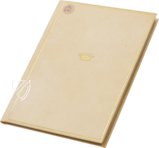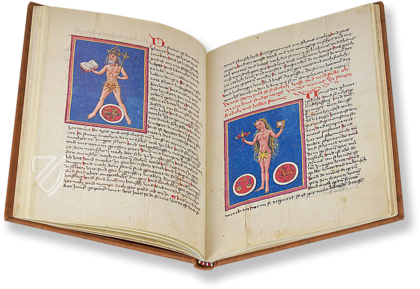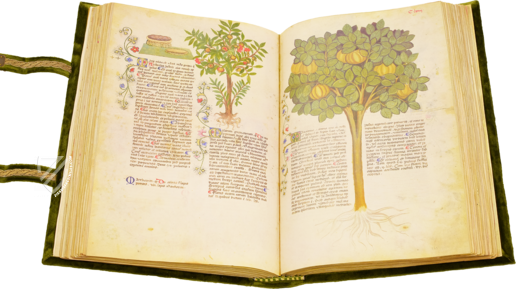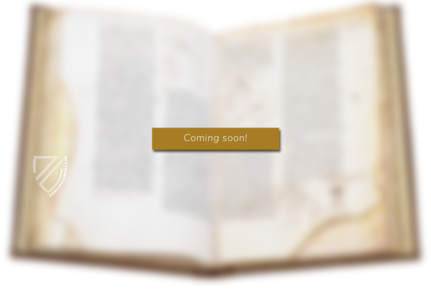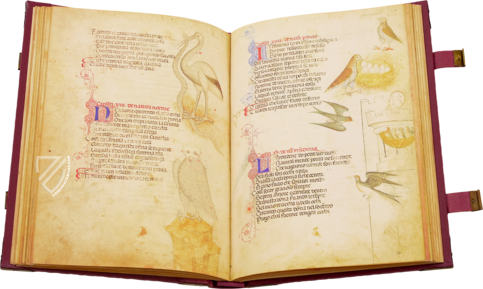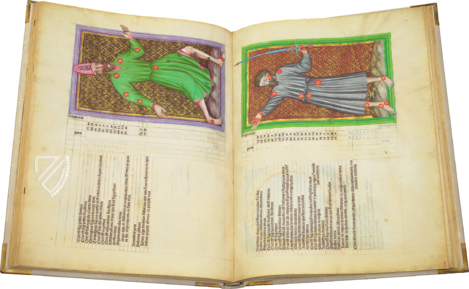Medical and Astrological Almanac
(1,000€ - 3,000€)
The Medical and Astrological Almanac was created ca. 1460 and is a fantastic manuscript which is simultaneously an annual calendar, medical guide, astrological guide, and almanac. It thus served the aristocratic medieval household as a general guidebook to life, health, weather, etc. and is filled with advice based on cosmic forces, the four humors, and other ancient traditions. The text is written in both Latin and German making generous use of expensive red ink. Originally believed to be part of a larger work, the surviving 24 pages contain colorful miniatures with gold leaf depicting the zodiac symbols, labors of the months, and other depictions of everyday life. The figures have a sweet and childlike appearance with rosy cheeks and kind faces. Researchers speculate that the manuscript originated from the Upper Rhine region, most likely for a patron in Strasbourg judging by the saints’ festivals included in the calendar.
Medical and Astrological Almanac
A wonderful glimpse of everyday life in the Upper Rhine region during the Late Middle Ages: the Medical and Astrological Almanac goes above and beyond the standard medieval calendar manuscript and contains advice regarding weather, health, and diet based upon the movements of the stars. Written in a Swiss-German dialect, the artistic style of the manuscript points to the region around Freiburg and Colmar ca. 1460. The medallion miniatures, zodiac signs, and other depictions resemble the work of the so-called “Master B”, who was associated with the Alsatian workshop of Diebold Lauber (active 1427–71). Saints’ festivals listed in the calendars indicate a recipient for the diocese of Strasbourg. However, further information eludes researchers because the 24 pages (12 leaves) appear to be a fragment of a larger manuscript. Nevertheless, the artist created wonderful miniatures of months’ labors and other activities with rich opaque colors and gold ink, and the scribe executed a gorgeous text in black, red, and blue ink.
Macrocosm and Microcosm
In the Middle Ages, it was believed that events in the cosmos, the “macrocosm”, had a clear effect on man as a “microcosm” thereof. According to this philosophical concept, the balance of humors in man’s body is effected by the changing forces of the stars and there is a connection between the four humors, four elements, four major winds, and four cardinal directions. Originally conceived of by Pythagoras and developed by Plato, the concept continued to be popular in the Middle Ages and attracted the attention of great minds like Hildegard von Bingen (1098–1179) and Leonardo da Vinci (1452–1519). While other medieval calendars show zodiac signs and constellations related to a month, what sets the Medical and Astrological Almanac apart is the processing of this information into specific advice that is elucidated in the text. For example, in May it is recommended that one should start the day with a glass of goat milk with fresh herbs. This manuscript was designed to be consulted regularly by “learned” medieval Europeans trying to keep their humors in balance.
Codicology
- Alternative Titles
- Astro-medizinischer Kalender
Astro-medizinischer Ratgeber - Size / Format
- 24 pages / 20.6 × 15.5 cm
- Origin
- France
- Date
- Ca. 1445
- Epochs
- Style
- Language
- Script
- Textura
- Illustrations
- 12 monthly medallions framed in gold, 12 signs of the zodiac and eleven scholarly images with 22 decorative gold arches; Rich pictorial decoration with gold and bright opaque colour painting
- Content
- Calendar with astronomical-medical information
- Artist / School
- Possibly Master B from the surroundings of the Lauber workshop
- Previous Owners
- David McCandless McKell
Medical and Astrological Almanac
Enthroned Astronomer
Crowned, seated, and holding an open book, the reoccurring character of the astronomer is depicted with ruddy cheeks and greying hair pointing toward a star. He is typical of the figures in the manuscript, who are characterized by strongly expressive gestures combined with naïve facial expressions. The text surrounding him contains prognostications for the month of June, which cautions against bloodletting, recommends hot drinks, and states thunder will be a bad omen for the fruit harvest.
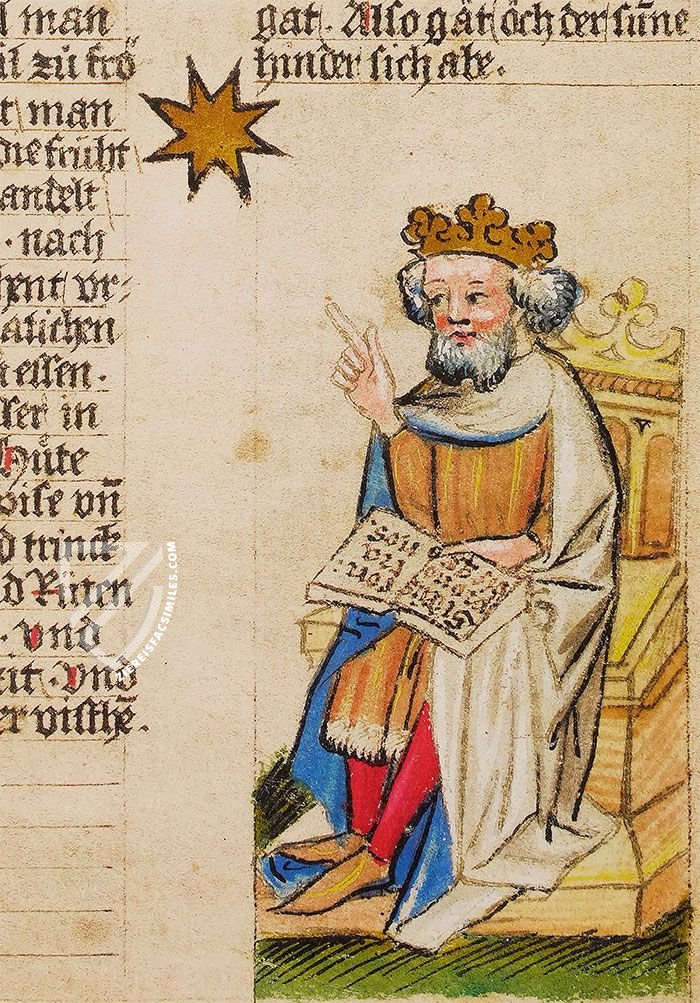
Medical and Astrological Almanac
January
Aquarius is symbolized by the beautiful Phrygian youth Ganymede, who is depicted wearing a grey tunic, shoes, and hat as well as blue tights and white gloves as he pours out his archetypal jug of water. He appears below a medallion containing a three-faced king sitting at a table and drinking wine. This figure symbolizes that the month of January is a time for looking into the bygone as well as the forthcoming year.
The local saints commemorated in the calendar are associated with the diocese of Strasbourg, e.g. Saint Erhard, an episcopus vagans or “wandering bishop” whose feast is celebrated on January 8th. Black, red, and blue-green ink has been expertly employed by the scribe, who also included an alphabet at the bottom of the page.
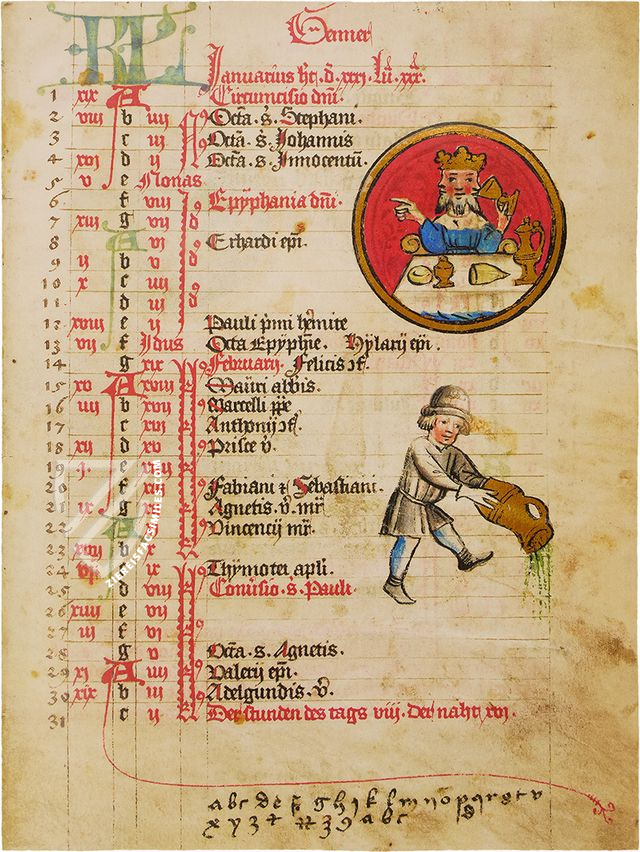
#1 Ein Astro-medizinischer Kalender
Language: German
All texts are transcribed and translated into New High German.
(1,000€ - 3,000€)
- Treatises / Secular Books
- Apocalypses / Beatus
- Astronomy / Astrology
- Bestiaries
- Bibles / Gospels
- Chronicles / History / Law
- Geography / Maps
- Saints' Lives
- Islam / Oriental
- Judaism / Hebrew
- Single Leaf Collections
- Leonardo da Vinci
- Literature / Poetry
- Liturgical Manuscripts
- Medicine / Botany / Alchemy
- Music
- Mythology / Prophecies
- Psalters
- Other Religious Books
- Games / Hunting
- Private Devotion Books
- Other Genres
- Afghanistan
- Armenia
- Austria
- Belgium
- Belize
- Bosnia and Herzegovina
- China
- Colombia
- Costa Rica
- Croatia
- Cyprus
- Czech Republic
- Denmark
- Egypt
- El Salvador
- Ethiopia
- France
- Germany
- Greece
- Guatemala
- Honduras
- Hungary
- India
- Iran
- Iraq
- Israel
- Italy
- Japan
- Jordan
- Kazakhstan
- Kyrgyzstan
- Lebanon
- Liechtenstein
- Luxembourg
- Mexico
- Morocco
- Netherlands
- Palestine
- Panama
- Peru
- Poland
- Portugal
- Romania
- Russia
- Serbia
- Spain
- Sri Lanka
- Sweden
- Switzerland
- Syria
- Tajikistan
- Turkey
- Turkmenistan
- Ukraine
- United Kingdom
- United States
- Uzbekistan
- Vatican City
- A. Oosthoek, van Holkema & Warendorf
- Aboca Museum
- Ajuntament de Valencia
- Akademie Verlag
- Akademische Druck- u. Verlagsanstalt (ADEVA)
- Aldo Ausilio Editore - Bottega d’Erasmo
- Alecto Historical Editions
- Alkuin Verlag
- Almqvist & Wiksell
- Amilcare Pizzi
- Andreas & Andreas Verlagsbuchhandlung
- Archa 90
- Archiv Verlag
- Archivi Edizioni
- Arnold Verlag
- ARS
- Ars Magna
- ArtCodex
- AyN Ediciones
- Azimuth Editions
- Badenia Verlag
- Bärenreiter-Verlag
- Belser Verlag
- Belser Verlag / WK Wertkontor
- Benziger Verlag
- Bernardinum Wydawnictwo
- BiblioGemma
- Biblioteca Apostolica Vaticana (Vaticanstadt, Vaticanstadt)
- Bibliotheca Palatina Faksimile Verlag
- Bibliotheca Rara
- Boydell & Brewer
- Bramante Edizioni
- Bredius Genootschap
- Brepols Publishers
- British Library
- C. Weckesser
- Caixa Catalunya
- Canesi
- CAPSA, Ars Scriptoria
- Caratzas Brothers, Publishers
- Carus Verlag
- Casamassima Libri
- Centrum Cartographie Verlag GmbH
- Chavane Verlag
- Christian Brandstätter Verlag
- Circulo Cientifico
- Club Bibliófilo Versol
- Club du Livre
- CM Editores
- Collegium Graphicum
- Collezione Apocrifa Da Vinci
- Comissão Nacional para as Comemorações dos Descobrimentos Portugueses
- Coron Verlag
- Corvina
- CTHS
- D. S. Brewer
- Damon
- De Agostini/UTET
- De Nederlandsche Boekhandel
- De Schutter
- Deuschle & Stemmle
- Deutscher Verlag für Kunstwissenschaft
- DIAMM
- Droz
- E. Schreiber Graphische Kunstanstalten
- Ediciones Boreal
- Ediciones Grial
- Ediclube
- Edições Inapa
- Edilan
- Editalia
- Edition Deuschle
- Edition Georg Popp
- Edition Leipzig
- Edition Libri Illustri
- Editiones Reales Sitios S. L.
- Éditions de l'Oiseau Lyre
- Editions Medicina Rara
- Editorial Casariego
- Editorial Mintzoa
- Editrice Antenore
- Editrice Velar
- Edizioni Edison
- Egeria, S.L.
- Eikon Editores
- Electa
- Emery Walker Limited
- Enciclopèdia Catalana
- Eos-Verlag
- Ephesus Publishing
- Ernst Battenberg
- Eugrammia Press
- Extraordinary Editions
- Fackelverlag
- Facsimila Art & Edition
- Facsimile Editions Ltd.
- Facsimilia Art & Edition Ebert KG
- Faksimile Verlag
- Feuermann Verlag
- Folger Shakespeare Library
- Franco Cosimo Panini Editore
- Friedrich Wittig Verlag
- Fundación Hullera Vasco-Leonesa
- G. Braziller
- Gabriele Mazzotta Editore
- Gebr. Mann Verlag
- Gesellschaft für graphische Industrie
- Getty Research Institute
- Giovanni Domenico de Rossi
- Giunti Editore
- Graffiti
- Grafica European Center of Fine Arts
- Guido Pressler
- Guillermo Blazquez
- Gustav Kiepenheuer
- H. N. Abrams
- Harrassowitz
- Harvard University Press
- Helikon
- Hendrickson Publishers
- Henning Oppermann
- Herder Verlag
- Hes & De Graaf Publishers
- Hoepli
- Holbein-Verlag
- Houghton Library
- Hugo Schmidt Verlag
- Idion Verlag
- Il Bulino, edizioni d'arte
- ILte
- Imago
- Insel Verlag
- Insel-Verlag Anton Kippenberger
- Instituto de Estudios Altoaragoneses
- Instituto Nacional de Antropología e Historia
- Introligatornia Budnik Jerzy
- Istituto dell'Enciclopedia Italiana - Treccani
- Istituto Ellenico di Studi Bizantini e Postbizantini
- Istituto Geografico De Agostini
- Istituto Poligrafico e Zecca dello Stato
- Italarte Art Establishments
- Jan Thorbecke Verlag
- Johnson Reprint Corporation
- Josef Stocker
- Josef Stocker-Schmid
- Jugoslavija
- Karl W. Hiersemann
- Kasper Straube
- Kaydeda Ediciones
- Kindler Verlag / Coron Verlag
- Kodansha International Ltd.
- Konrad Kölbl Verlag
- Kurt Wolff Verlag
- La Liberia dello Stato
- La Linea Editrice
- La Meta Editore
- Lambert Schneider
- Landeskreditbank Baden-Württemberg
- Leo S. Olschki
- Les Incunables
- Liber Artis
- Library of Congress
- Libreria Musicale Italiana
- Lichtdruck
- Lito Immagine Editore
- Lumen Artis
- Lund Humphries
- M. Moleiro Editor
- Maison des Sciences de l'homme et de la société de Poitiers
- Manuscriptum
- Martinus Nijhoff
- Maruzen-Yushodo Co. Ltd.
- MASA
- Massada Publishers
- McGraw-Hill
- Metropolitan Museum of Art
- Militos
- Millennium Liber
- Müller & Schindler
- Nahar - Stavit
- Nahar and Steimatzky
- National Library of Wales
- Neri Pozza
- Nova Charta
- Oceanum Verlag
- Odeon
- Orbis Mediaevalis
- Orbis Pictus
- Österreichische Staatsdruckerei
- Oxford University Press
- Pageant Books
- Parzellers Buchverlag
- Patrimonio Ediciones
- Pattloch Verlag
- PIAF
- Pieper Verlag
- Plon-Nourrit et cie
- Poligrafiche Bolis
- Presses Universitaires de Strasbourg
- Prestel Verlag
- Princeton University Press
- Prisma Verlag
- Priuli & Verlucca, editori
- Pro Sport Verlag
- Propyläen Verlag
- Pytheas Books
- Quaternio Verlag Luzern
- Reales Sitios
- Recht-Verlag
- Reichert Verlag
- Reichsdruckerei
- Reprint Verlag
- Riehn & Reusch
- Roberto Vattori Editore
- Rosenkilde and Bagger
- Roxburghe Club
- Salerno Editrice
- Saltellus Press
- Sandoz
- Sarajevo Svjetlost
- Schöck ArtPrint Kft.
- Schulsinger Brothers
- Scolar Press
- Scrinium
- Scripta Maneant
- Scriptorium
- Shazar
- Siloé, arte y bibliofilia
- SISMEL - Edizioni del Galluzzo
- Sociedad Mexicana de Antropología
- Société des Bibliophiles & Iconophiles de Belgique
- Soncin Publishing
- Sorli Ediciones
- Stainer and Bell
- Studer
- Styria Verlag
- Sumptibus Pragopress
- Szegedi Tudomànyegyetem
- Taberna Libraria
- Tarshish Books
- Taschen
- Tempus Libri
- Testimonio Compañía Editorial
- Thames and Hudson
- The Clear Vue Publishing Partnership Limited
- The Facsimile Codex
- The Folio Society
- The Marquess of Normanby
- The Richard III and Yorkist History Trust
- Tip.Le.Co
- TouchArt
- TREC Publishing House
- TRI Publishing Co.
- Trident Editore
- Tuliba Collection
- Typis Regiae Officinae Polygraphicae
- Union Verlag Berlin
- Universidad de Granada
- University of California Press
- University of Chicago Press
- Urs Graf
- Vallecchi
- Van Wijnen
- VCH, Acta Humaniora
- VDI Verlag
- VEB Deutscher Verlag für Musik
- Verlag Anton Pustet / Andreas Verlag
- Verlag Bibliophile Drucke Josef Stocker
- Verlag der Münchner Drucke
- Verlag für Regionalgeschichte
- Verlag Styria
- Vicent Garcia Editores
- W. Turnowski Ltd.
- W. Turnowsky
- Waanders Printers
- Wiener Mechitharisten-Congregation (Wien, Österreich)
- Wissenschaftliche Buchgesellschaft
- Wissenschaftliche Verlagsgesellschaft
- Wydawnictwo Dolnoslaskie
- Xuntanza Editorial
- Zakład Narodowy
- Zollikofer AG

